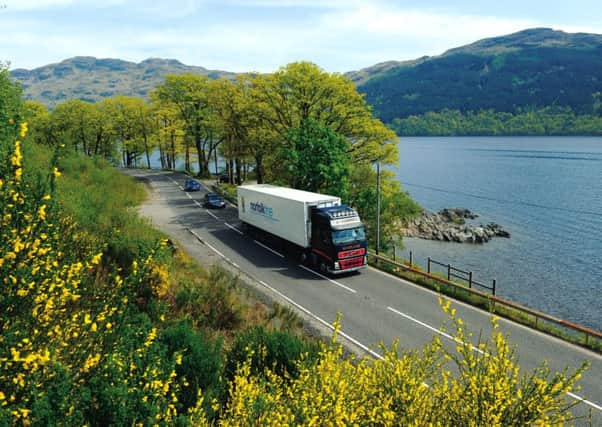What does it take to get Scottish food from farm to fork?


Consumers are placing more and more of an emphasis on “farm to fork” produce. They want to know where the chickens that laid the eggs that made their omelette were reared, whether they were free range or battery hens, and if they were fed on Scottish corn.
The same goes for so much of the food and drink that is coming out of Scotland today from rapeseed oil produced in the fields of East Lothian to strawberries grown and picked in Tayside or Angus, or vodka made with potatoes from a farm in Fife.
Advertisement
Hide AdAdvertisement
Hide Ad“Farm-to-table” is a concept that has really taken off in the United States; San Francisco’s restaurant scene, for example, is packed with eateries promoting their low-food-miles menus and where the waiters can tell diners the exact origin of those Californian pistachios or ripe avocados, and how they came to arrive on a plate, slate or any other innovative feasting platter.


On this side of the Atlantic, farm shops and farmers’ markets have certainly taken off and Scottish producers pride themselves on their ability to get fresh salmon from Shetland to sushi restaurants in the Far East in about the same time as it takes to drive from the West Coast to the Central Belt.
Their produce is recognised by chefs and retailers as being fresh and high quality, often commanding premium prices, but it’s not all plain sailing for companies looking to broaden their horizons and explore new markets.
Alan Stevenson, supply chain development director at the Scottish Agricultural Organisation Society (SAOS), says part of the challenge for Scottish businesses is their size, which can be restrictive when it comes to embracing fully the growth opportunities open to them.
“We have a very large proportion of small businesses – well over 80 per cent – and they don’t all necessarily have the skills, capacity and capability to respond to these great opportunities, even though they have great products,” says Stevenson.


“A lot of the work we do is to help those companies to have a robust supply chain if we are going to be able to capitalise on this opportunity.
“We are looking at where the issues and barriers are to that growth. We often find it can be at any point in the supply chain.”
He says the first stage is to look at what the primary product is – seafood, beef, cereals – and identify an opportunity with a partner organisation like Scotland Food & Drink before mapping out the chain.
Advertisement
Hide AdAdvertisement
Hide Ad“The barriers can be right down at the primary end where [a business] is not doing something quite right to suit the market and we might need to encourage the farmers to work with the processors to get more volume coming through at the quality that the market wants.
“It could be at the market end in Japan or Canada where we are looking at how we get into that market, how their system works and do we need an agent, a wholesaler or a distributor.”
The answer to making this work, particularly for smaller businesses, is to deepen collaboration, and the benefits are set out in Scotland Food & Drink’s Market Driven Supply Chain (MDSC) initiative which is a key contributor to the Ambition 2030 strategy.
The overall objective is to develop the capabilities of 20 food and drink supply chains to exploit fullyopportunities in the UK and international markets, and deliver an aggregated increase in turnover of at least £24 million by 2020.
“The journey from farm to plate has a lot of different players,” says James Withers, chief executive of Scotland Food & Drink.
“If you are a farmer with a herd of beef cattle, you might go to a livestock market and sell them in the ring. A processor will then buy that and turn it into different products.
“You might then have a secondary processor and you have it going into a retail or food service environment. If it is going to, say, a hotel restaurant, there is then a wholesaler in the middle.
“Farmers have become quite detached from that end marketplace. We need to fix that and get them closer to the market.”
Advertisement
Hide AdAdvertisement
Hide AdIt’s about collaboration and closing that gap, but there is also potential financial gain that could come from slimming down the supply chain.
“Crucially, every player in the chain needs to make a margin out of that product,” says Withers.
“What we would like to do is shorten the supply chains and get the ultimate producer closer to the consumer and keep as much value from our food and drink in Scotland as we can.”
Within that chain there is also logistics, so what does it take to transport our food and drink offering from A to B, economically and efficiently?
“In terms of scale in green logistics, the seafood industry does its best to fill every truck as full as possible when they are bringing it down from Peterhead to the continent,” says Stevenson.
At the other end of the scale are the artisan producers who are making and packaging smoked salmon on the West Coast, bottling beer by the banks of Loch Fyne or manufacturing ice cream on an island farm. For them, filling a lorry to capacity and sending it around the world isn’t necessarily an option.
Innovation comes into play here, with Stevenson and his colleagues working on an exciting pilot project in Argyll and Bute, which he dubs a kind of “Uber” for local producers.
“We are looking at a version of distribution whereby if a business is passing other businesses, they will pick up their products, get a small fee for it, and drop them off wherever they are going,” he explains. “That’s a very efficient way of transporting goods.”
Advertisement
Hide AdAdvertisement
Hide AdWithers agrees that some of the more rural businesses can struggle with distribution. “In a place like Scotland where we have remote peripheral areas, logistics can be difficult.
“There will be lorries and trucks going out on CalMac ferries that are doing two things; they are bringing products on to the islands and they are taking things off.
“We need to develop innovative platforms to connect companies with other companies that are also trying to get a product from A to B.
“That’s where the whole area around e-commerce is going to transform supply chains.”
But of course there’s that elephant in the room which continues plague many of Scotland’s rural communities: connectivity.
“We will need a revolution in that area,” says Withers.
Stevenson highlights companies like Amazon which are moving into direct food sales online and in doing so changing the way the consumer accesses produce.
“As well as traditional ways of [distribution], something we have to think about is more direct-to-consumer logistics,” he says.
“We need to look at how Scottish companies can benefit from that approach. It’s about looking to the future and trying to keep ahead of the game as much as possible.”